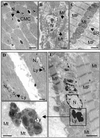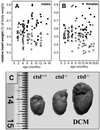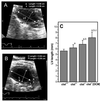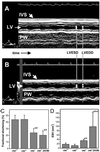Dilated cardiomyopathy in mice deficient for the lysosomal cysteine peptidase cathepsin L
- PMID: 11972068
- PMCID: PMC122932
- DOI: 10.1073/pnas.092637699
Dilated cardiomyopathy in mice deficient for the lysosomal cysteine peptidase cathepsin L
Abstract
Dilated cardiomyopathy is a frequent cause of heart failure and is associated with high mortality. Progressive remodeling of the myocardium leads to increased dimensions of heart chambers. The role of intracellular proteolysis in the progressive remodeling that underlies dilated cardiomyopathy has not received much attention yet. Here, we report that the lysosomal cysteine peptidase cathepsin L (CTSL) is critical for cardiac morphology and function. One-year-old CTSL-deficient mice show significant ventricular and atrial enlargement that is associated with a comparatively small increase in relative heart weight. Interstitial fibrosis and pleomorphic nuclei were found in the myocardium of the knockout mice. By electron microscopy, CTSL-deficient cardiomyocytes contained multiple large and apparently fused lysosomes characterized by storage of electron-dense heterogeneous material. Accordingly, the assessment of left ventricular function by echocardiography revealed severely impaired myocardial contraction in the CTSL-deficient mice. In addition, echocardiographic and electrocardiographic findings to some degree point to left ventricular hypertrophy that most likely represents an adaptive response to cardiac impairment. The histomorphological and functional alterations of CTSL-deficient hearts result in valve insufficiencies. Furthermore, abnormal heart rhythms, like supraventricular tachycardia, ventricular extrasystoles, and first-degree atrioventricular block, were detected in the CTSL-deficient mice.
Figures






Similar articles
-
Lysosomal, cytoskeletal, and metabolic alterations in cardiomyopathy of cathepsin L knockout mice.FASEB J. 2006 Jun;20(8):1266-8. doi: 10.1096/fj.05-5517fje. Epub 2006 Apr 24. FASEB J. 2006. PMID: 16636100
-
Cell type-specific functions of the lysosomal protease cathepsin L in the heart.J Biol Chem. 2007 Dec 21;282(51):37045-52. doi: 10.1074/jbc.M703447200. Epub 2007 Oct 17. J Biol Chem. 2007. PMID: 17942402
-
Lysosomal cysteine peptidase cathepsin L protects against cardiac hypertrophy through blocking AKT/GSK3beta signaling.J Mol Med (Berl). 2009 Mar;87(3):249-60. doi: 10.1007/s00109-008-0423-2. Epub 2008 Dec 19. J Mol Med (Berl). 2009. PMID: 19096818
-
Towards specific functions of lysosomal cysteine peptidases: phenotypes of mice deficient for cathepsin B or cathepsin L.Biol Chem. 2001 May;382(5):735-41. doi: 10.1515/BC.2001.089. Biol Chem. 2001. PMID: 11517926 Review.
-
[Obesity and cardiac failure].Arch Mal Coeur Vaiss. 2005 Jan;98(1):39-45. Arch Mal Coeur Vaiss. 2005. PMID: 15724418 Review. French.
Cited by
-
ABCA5 resides in lysosomes, and ABCA5 knockout mice develop lysosomal disease-like symptoms.Mol Cell Biol. 2005 May;25(10):4138-49. doi: 10.1128/MCB.25.10.4138-4149.2005. Mol Cell Biol. 2005. PMID: 15870284 Free PMC article.
-
A Review of Small Molecule Inhibitors and Functional Probes of Human Cathepsin L.Molecules. 2020 Feb 6;25(3):698. doi: 10.3390/molecules25030698. Molecules. 2020. PMID: 32041276 Free PMC article. Review.
-
Mitophagy and heart failure.J Mol Med (Berl). 2015 Mar;93(3):253-62. doi: 10.1007/s00109-015-1254-6. Epub 2015 Jan 23. J Mol Med (Berl). 2015. PMID: 25609139 Free PMC article. Review.
-
Induction of cardiac fibulin-4 protects against pressure overload-induced cardiac hypertrophy and heart failure.Commun Biol. 2025 Apr 24;8(1):661. doi: 10.1038/s42003-025-08087-8. Commun Biol. 2025. PMID: 40274989 Free PMC article.
-
Age and gender related reference values for transthoracic Doppler-echocardiography in the anesthetized CD1 mouse.Int J Cardiovasc Imaging. 2006 Jun-Aug;22(3-4):353-62. doi: 10.1007/s10554-005-9052-9. Epub 2006 Mar 4. Int J Cardiovasc Imaging. 2006. PMID: 16518668
References
-
- Kamisago M, Sharma S D, DePalma S R, Solomon S, Sharma P, McDonough B, Smoot L, Mullen M P, Woolf P K, Wigle E D, et al. N Engl J Med. 2000;343:1688–1696. - PubMed
-
- Olson T M, Michels V V, Thibodeau S N, Tai Y S, Keating M T. Science. 1998;280:750–752. - PubMed
-
- Li D, Tapscoft T, Gonzalez O, Burch P E, Quinones M A, Zoghbi W A, Hill R, Bachinski L L, Mann D L, Roberts R. Circulation. 1999;100:461–464. - PubMed
-
- Towbin J A, Hejtmancik J F, Brink P, Gelb B, Zhu X M, Chamberlain J S, McCabe E R, Swift M. Circulation. 1993;87:1854–1865. - PubMed
Publication types
MeSH terms
Substances
LinkOut - more resources
Full Text Sources
Other Literature Sources
Molecular Biology Databases

